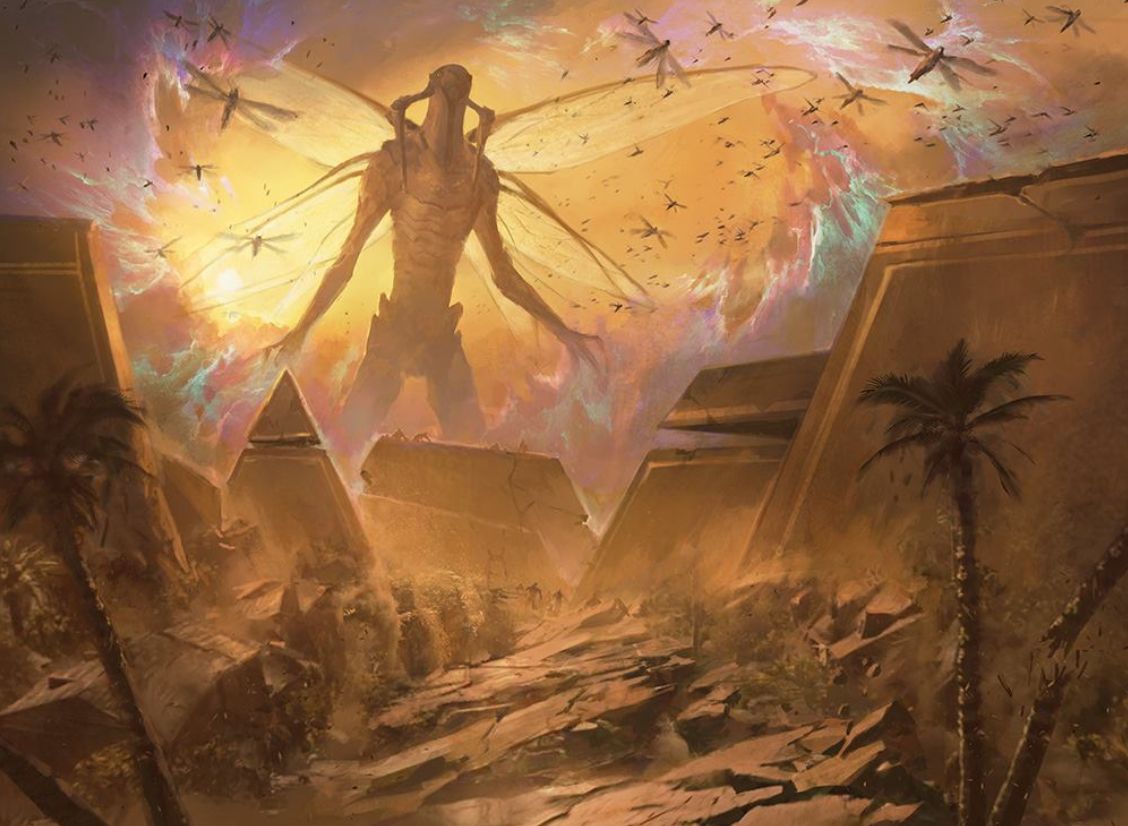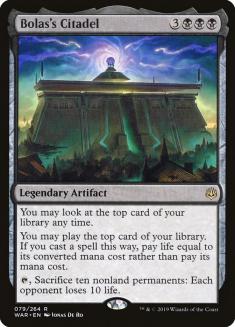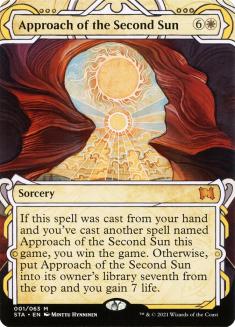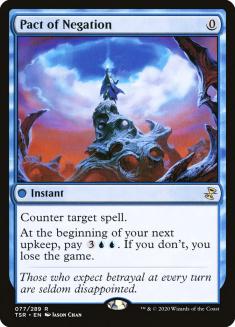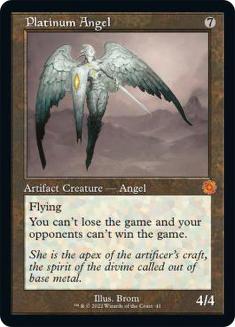Welcome to What We'd Play! With the introduction of Amonkhet Remastered, many are unsure what they’d play in Historic. That’s where we come in and let you know what we’d play and why we’d play it. Hopefully this advice aids in your decision making for your next Historic event! Be sure to vote for what deck you would play at the end!
Ryan Overturf — Mono-Red Goblins
Creatures (37)
- 4 Goblin Matron
- 4 Goblin Warchief
- 1 Gempalm Incinerator
- 4 Skirk Prospector
- 4 Goblin Chieftain
- 4 Krenko, Mob Boss
- 4 Wily Goblin
- 4 Goblin Instigator
- 4 Conspicuous Snoop
- 4 Muxus, Goblin Grandee
Lands (23)

Mono-Red Goblins can still win on Turn 3 and people still underrate it. Hushbringer is an irritating card to play against, but you have draws that beat such hate cards easily utilizing Conspicuous Snoop and Krenko, Mob Boss. The chatter about killing Skirk Prospector beating this deck is also totally overblown. As the Goblins player you often just play out your hand and save the Prospector for the Muxus turn, and I feel like people generally don’t understand this deck from the way I see it talked about. The deck has a lot of cards that generate card advantage and/or mana advantage and Muxus is just a one-card combo.
In my experience, a Wilderness Reclamation player casting multiple Magmaquakes was the worst case scenario for Goblins, and with Reclamation banned I really like the deck’s position. My list here isn’t doing anything terribly fancy, though if Mono-Blue Aggro becomes popular I like the idea of turning some of the sideboard Goblin Ringleaders into one-mana removal spells just so you have more play against counterspells and answers to early Curious Obsessions. Shock might be the right call, but I find Fanatical Firebrand very charming.
Paulo Vitor Damo da Rosa — Sultai Ramp
Creatures (8)
Planeswalkers (1)
Lands (31)
- 2 Forest
- 1 Swamp
- 1 Island
- 2 Overgrown Tomb
- 2 Watery Grave
- 2 Breeding Pool
- 1 Drowned Catacomb
- 1 Bojuka Bog
- 1 Hinterland Harbor
- 1 Woodland Cemetery
- 1 Jungle Hollow
- 1 Fetid Pools
- 1 Ipnu Rivulet
- 1 Ifnir Deadlands
- 1 Hashep Oasis
- 1 Blast Zone
- 4 Field of the Dead
- 4 Fabled Passage
- 1 Zagoth Triome
- 1 Ketria Triome
- 1 Indatha Triome
Spells (20)

My deck of choice for Historic was originally Temur Reclamation with Field of the Dead, but with the Wilderness Reclamation ban, that’s no longer a viable option. Field of the Dead is still an incredibly powerful card, however, and there’s a lot of support for it in the format — even more so than before, actually, with the printing of Hour of Promise — so I believe trying to find the best Field of the Dead shell is a very rewarding prospect.
I’ve been toying with some different Bant configurations that include Sphinx’s Revelation, but the Sultai version seems the best so far. The deck I’m playing right now is based on Tom Tracey’s list that got first place in the Hooglandia Open this past weekend, except my mana base is a bit different and I don’t like Cultivate. Cultivate just isn’t a very powerful card, and if you run Cultivate you need to either double up on a lot of basics or eschew some numbers of Fabled Passage, both of which I dislike.
This deck has both Uro, Titan of Nature’s Wrath and Field of the Dead, so Fabled Passage is an incredible land, and now that you have the Deserts (such as Ifnir Deadlands) you don’t need to play as many basic lands.
Ben Friedman — Selesnya Company
Creatures (28)
- 3 Azusa, Lost but Seeking
- 4 Llanowar Elves
- 4 Knight of the Reliquary
- 2 Scavenging Ooze
- 3 Thalia, Guardian of Thraben
- 4 Ramunap Excavator
- 4 Elvish Reclaimer
- 4 Dryad of the Ilysian Grove
Lands (28)
Spells (4)
Sideboard

Remember Maverick in Legacy? It’s back! Historic is a weird format with some Legacy-quality cards, some Modern-quality ones, and some Pioneer-quality ones all coming together to make something new.
This deck is a healthy mix of mana denial elements (see Thalia, Guardian of Thraben and Ghost Quarter loops) and aggressive starts. If your opponent’s manabase is fragile at all, this deck will exploit it. If your opponent tries to get fancy with their graveyard, you have the appropriate ways to fight it with Scavenger Grounds, Scavenging Ooze, and Bojuka Bog. And if they’re chock-full of removal, your Collected Company can dig up multiple big creatures to start smashing face. You even have Field of the Dead to churn out Zombies with Azusa, Lost but Seeking and Ramunap Excavator. Just keep churning out those land drops and overpower your opponent!
Historic right now looks like Legacy did a decade ago, and it’s thrilling to watch it evolve. I’ll be battling with this cross between Legacy Maverick and Modern Selesnya Company.
Patrick Chapin — Bant Ramp
Creatures (6)
Planeswalkers (2)
Lands (31)
- 2 Forest
- 2 Plains
- 1 Island
- 2 Temple Garden
- 2 Breeding Pool
- 2 Hallowed Fountain
- 1 Glacial Fortress
- 1 Sunpetal Grove
- 1 Hinterland Harbor
- 1 Temple of Mystery
- 1 Temple of Enlightenment
- 1 Temple of Plenty
- 1 Irrigated Farmland
- 1 Scattered Groves
- 1 Desert of the True
- 1 Scavenger Grounds
- 1 Ipnu Rivulet
- 1 Hashep Oasis
- 1 Blast Zone
- 4 Field of the Dead
- 1 Castle Vantress
- 2 Fabled Passage
Spells (21)

As if Hour of Promise wasn’t enough, Amonkhet Remastered also gave us access to Wrath of God and Sphinx’s Revelation, making Bant Ramp my preferred approach to Field of the Dead, this week. Hour of Promise does a pretty mean Primeval Titan impression, and getting to play eight Growth Spirals and Explores is just crazy. Thoughtseize is a very appealing reason to play black, but with how well positioned Field of the Dead seems, I wanted to play Sphinx’s Revelation to go over the top of other Field of the Dead decks.
I liked Sandoiche’s Top 8 list from Hooglandia Open 5 the most of the Field of the Dead decks I discussed yesterday; though I did want to try a Finale of Revelation instead of one of the two Sphinx’s Revelations (even if it’s pretty speculative) as an additional way to go even more over the top. Without it, I think I’d be sorely tempted to get one Ulamog, the Ceaseless Hunger into the maindeck.
Carmen Handy — Jund Sacrifice
Creatures (29)
- 4 Llanowar Elves
- 4 Blood Artist
- 4 Priest of Forgotten Gods
- 4 Paradise Druid
- 4 Mayhem Devil
- 4 Gilded Goose
- 4 Woe Strider
- 1 Fiend Artisan
Lands (20)
Spells (11)

Historic is still a wide open format, but that doesn’t mean you have to skimp on card quality. Ever since it was previewed, Collected Company has been slated to absolutely dominate Historic. With most of the best cards in Historic being creatures, and synergies being more powerful than ever, having a card that can act as selection, tempo-positive, and card advantage is a huge boon to this type of deck. And that’s not even factoring in the combo kills.
When Bolas’s Citadel was previewed, it was a card I was all over, even building some absurd Children of Korlis Storm decks in Modern to try and make it happen. In a deck that’s interested in simply generating a ton of on-battlefield material, the card can do what Standard Sacrifice decks wanted God-Eternal Bontu to do towards the end of last year, while still killing people in the same way that Mayhem Devil does.
Having a deck that’s proactive, consistent, and powerful is the perfect recipe for success when attacking a format in its infancy. With Mythic Champion Matias Leveratto’s Jund Sacrifice list, all of those boxes are checked and I’d be happy taking the archetype into battle.
Cedric Phillips — Mono-Blue Aggro
If Historic is going to revolve around Field of the Dead cancelling aggressive and midrange strategies, Mono-Blue Aggro is the best aggressive strategy to be playing for two reasons — flying and counterspells. Flying lets you sail over the numerous Zombies that Field of the Dead creates and the counterspells keep decks based around Field of the Dead off balance long enough to get the job done.
Note that playing Mono-Blue Aggro is risky, as your Mono-Red Aggro matchup is pretty dubious and I don’t think playing against something based around Collected Company is ideal. Yes, your best draws can beat anything but you can say that about any deck in any format. Your average draw is… well… average, making this a metagame deck as opposed to the best deck in the format.
Shaheen Soorani — Azorius Approach
Planeswalkers (9)
Lands (26)
Spells (25)

Control is far from dead in Historic, even with Field of the Dead running rampant. The traditional method of resolving sturdy planeswalkers and ending the game through tough attrition is my favorite way to win; however, that’s not a possible road to travel these days. Field of the Dead does that plan much better and cards like Teferi, Hero of Dominaria simply cannot bring it home. In these dark times, we look to the sun for assistance.
Approach of the Second Sun is the cleanest win condition against ramp and aggressive decks out there. Although the matchup against ramp is still tough, we at least have a fighting chance with this expensive sorcery, in comparison to a more traditional control victory. The return of Wrath of God, Sphinx’s Revelation, Censor, Gideon of the Trials, Pact of Negation, and Rest in Peace provide a huge boost to the archetype, providing an instant framework for control success in Historic. It’s good now, but once Field of the Dead is banned, this deck will be a force to be reckoned with.
Michael Majors — Temur Ramp
Creatures (5)
Lands (30)
Spells (25)
- 2 Pact of Negation
- 4 Explore
- 3 Censor
- 1 Supreme Will
- 4 Hour of Promise
- 2 Expansion
- 4 Growth Spiral
- 3 Flame Sweep
- 2 Aether Gust
Sideboard

In some ways this is just taking the normal Sultai Ramp deck and making some tiny adjustments — removing Black for Thoughtseize and adding Red for Flame Sweep, a massively powerful sweeper against both Goblins and the now instant-speed nature of creature decks with Collected Company. In others, I think there are some pretty large adjustments to the archetype.
Having both more interaction and the ability to tap out while threatening interaction with Pact of Negation is a big deal in a format as powerful and full of linear strategies as Historic. Further, I’ve added the Pact of Negation + Platinum Angel combination in my sideboard, which is lights out against multiple strategies.
All of this on top of one of the best threats in Field and ways to get ahead — Hour of Promise (which can also contribute to card selection or answering problematic permanents with Castle Vantress and Blast Zone) makes Temur Ramp a worthy candidate for the best deck in Historic.
Sam Black — Bant Ramp
Creatures (9)
Planeswalkers (2)
Lands (33)
- 2 Forest
- 2 Plains
- 2 Island
- 1 Temple Garden
- 1 Breeding Pool
- 1 Hallowed Fountain
- 1 Glacial Fortress
- 1 Sunpetal Grove
- 1 Bojuka Bog
- 1 Hinterland Harbor
- 1 Temple of Mystery
- 1 Temple of Enlightenment
- 1 Temple of Plenty
- 1 Radiant Fountain
- 1 Irrigated Farmland
- 1 Scattered Groves
- 1 Field of Ruin
- 1 Arch of Orazca
- 1 Blast Zone
- 4 Field of the Dead
- 3 Fabled Passage
- 1 Zagoth Triome
- 1 Ketria Triome
- 1 Raugrin Triome
- 1 Indatha Triome
Spells (16)

It seems to strange to play white rather than black, given all the tools black has available and that Languish is often very similar to Wrath of God, but I think Wrath of God is the better card and I haven’t been impressed by any of the black tools. I think Wrath of God is the best card to cover your bases against creature decks, and that the best plan against opposing ramp decks is just to focus on getting more lands on the battlefield. I respect Bolas’s Citadel-based decks, which is why I prioritize Wrath of God and play three Grafdigger’s Cages in the sideboard. I think it’s easier for opponents to come prepared for Bolas’s Citadel strategies and I think it’s a mistake not to play Field of the Dead with Hour of Promise while these cards are legal.

